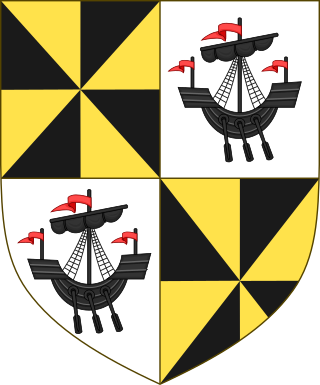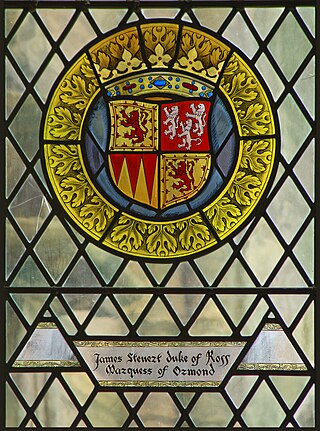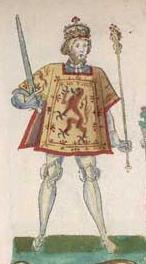
The wars of Scottish Independence were a series of military campaigns fought between the Kingdom of Scotland and the Kingdom of England in the late 13th and early 14th centuries.

James IV was King of Scotland from 11 June 1488 until his death at the Battle of Flodden in 1513. He inherited the throne at the age of fifteen on the death of his father, James III, at the Battle of Sauchieburn, following a rebellion in which the younger James was the figurehead of the rebels. James IV is generally regarded as the most successful of the Stewart monarchs. He was responsible for a major expansion of the Scottish royal navy, which included the founding of two royal dockyards and the acquisition or construction of 38 ships, including the Michael, the largest warship of its time.

James III was King of Scots from 1460 until his death at the Battle of Sauchieburn in 1488. He inherited the throne as a child following the death of his father, King James II, at the siege of Roxburgh Castle. James III's reign began with a minority that lasted almost a decade, during which Scotland was governed by a series of regents and factions who struggled for possession of the young king, before his personal rule began in 1469.

Duke of Rothesay is the main dynastic title traditionally given to the male heir apparent to the Scottish and, later, British thrones. The dukedom was created in 1398 by Robert III of Scotland for his eldest son.

Lord of the Isles or King of the Isles (Scottish Gaelic: Triath nan Eilean or Rìgh Innse Gall) is a title of Scottish nobility with historical roots that go back beyond the Kingdom of Scotland. It began with Somerled in the 12th century and thereafter the title was held by a series of his descendants, the Norse-Gaelic rulers of the Isle of Man and Argyll and the islands of Scotland in the Middle Ages. They wielded sea-power with fleets of galleys (birlinns). Although they were, at times, nominal vassals of the kings of Norway, Ireland, or Scotland, the island chiefs remained functionally independent for many centuries. Their territory included much of Argyll, the Isles of Arran, Bute, Islay, the Isle of Man, Hebrides, Knoydart, Ardnamurchan, and the Kintyre peninsula. At their height they were the greatest landowners and most powerful lords after the kings of England and Scotland.

Colin Campbell, 1st Earl of Argyll was a medieval Scottish nobleman, peer, and politician. He was the son of Archibald Campbell, Master of Campbell and Elizabeth Somerville, daughter of John Somerville, 3rd Lord Somerville. He had the sobriquet Colin Mulle, Bold Earl Colin.

Brodick Castle is a castle situated outside the port of Brodick on the Isle of Arran, an island in the Firth of Clyde, Scotland. It was previously a seat of the Dukes of Hamilton, but is now owned by the National Trust for Scotland. The castle is a Category A listed building and the grounds are included in the Inventory of Gardens and Designed Landscapes in Scotland.

Alexander Stewart, Duke of Albany, was a Scottish prince and the second surviving son of King James II of Scotland. He fell out with his older brother, King James III, and fled to France, where he unsuccessfully sought help. In 1482 he invaded Scotland with the army of King Edward IV of England and assumed control of the country. Scottish lords turned against him in 1483 and he fled after King Edward died. The second invasion, in 1484, was not supported by the new English king, King Richard III, and failed. He died in a duel with Louis XII of France, Duke of Orléans, by a splinter from Louis's lance.

Archibald Douglas, 5th Earl of Angus was a Scottish nobleman, peer, politician, and magnate. Tradition has accorded him the nickname Archibald 'Bell-the-Cat' due to his association with the 1482 rebellion against James III of Scotland. He became one of the most powerful nobleman in Scotland through his influential position on the Scottish Marches, and a willingness to be involved in multiple rebellions in the reigns of James III and James IV of Scotland.
Patrick III, 7th Earl of Dunbar was lord of the feudal barony of Dunbar and its castle, which dominated East Lothian, and the most important military personage in the Scottish Borders.

James Stewart, Duke of Ross was a Scottish prince, and the second son of King James III of Scotland and his wife, Margaret of Denmark. James was heir presumptive to his brother until his death, and was Archbishop of St Andrews and Lord Chancellor of Scotland.
John of Islay (1434–1503), Earl of Ross, fourth Lord of the Isles, and Mac Domhnaill, was a pivotal figure in late medieval Scotland: specifically in the struggle for power with James Stewart, James III of Scotland, in the remoter formerly Norse-dominated regions of the kingdom. His defeat in this conflict led to rebellion against John by his illegitimate son Angus Óg, resulting in the defeat of John's fleet at the Battle of Bloody Bay in the early 1480s. Thereafter and until his death in 1503 John remained an inconsequential figure while, until his murder in 1490, Angus continued to dominate the affairs of Clan Donald. In 1493 James IV brought the Lordship of the Isles to an end.
The Treaty of Perpetual Peace was signed by James IV of Scotland and Henry VII of England in 1502. It agreed to end the intermittent warfare between Scotland and England which had been waged over the previous two hundred years, and, although it failed in this respect, as hostilities continued intermittently throughout the 16th century, it led to the Union of the Crowns 101 years later.
William Crichton, 1st Lord Crichton was an important political figure in the late medieval Kingdom of Scotland.

Ardtornish Castle is a castle situated in the grounds of the Ardtornish estate in Morvern, on the west coast of Scotland. It stands at the seaward end of a promontory which extends in a southerly direction into the Sound of Mull, about 1 mile south-east of the village of Lochaline, Highland. It is protected as a scheduled monument.

John Douglas, Lord of Balvenie was the youngest of the five Black Douglas brothers, who rebelled against King James II of Scotland.
Lachlan Óg Maclean, was the 8th Chief of Maclean.
In July 1482 an English army invaded Scotland during the Anglo-Scottish Wars. The town of Berwick-upon-Tweed and its castle were captured and the English army briefly occupied Edinburgh. These events followed the signing of the Treaty of Fotheringhay, 11 June 1482, in which Alexander Stewart, Duke of Albany, the brother of James III of Scotland declared himself King of Scotland and swore loyalty to Edward IV of England. The follow-up invasion of Scotland under the command of Edward's brother, Richard, Duke of Gloucester failed to install Albany on the throne, but Berwick has remained English ever since the castle surrendered on 24 August. The English army left Edinburgh with a promise for the repayment of the dowry paid for the marriage of Princess Cecily of England to the Scottish Prince.
John Mor MacDonald, fl. 1499, was third lord of Clan Donald.

The Treaty of York (1464) was made between England and Scotland on 1 June 1464 at York and was intended to establish 15 years of peace. Previously Scotland had supported the defeated House of Lancaster in the English civil War of the Roses.













